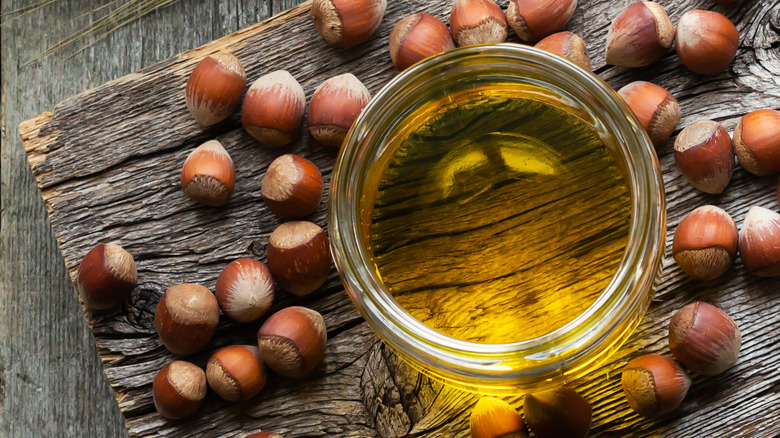Hazelnut Oil Is More Versatile Than You Might Think
Hazelnuts can be chopped into cookies and transformed into delicious chocolate spreads like Nutella, but did you know that they can also be used to make oil? A growing trend, Consumer Reports explains that there's been a shift away from standard cooking oils in favor of more unique offerings from avocado to toasted sesame and even hazelnut oil. While it might seem super niche, hazelnut oil is actually more versatile than you might think.
Like many other nut oils, hazelnuts undergo a fairly similar extraction process. According to Oregon Hazelnuts, the filberts may be roasted or simply ground before being mechanically pressed to extract the oil from the kernels. The resulting liquid can range from golden to amber with an intensely nutty aroma and a luxurious mouthfeel.
Whether you're whipping up something sweet or savory, hazelnut oil has the power to transform even the drabbest of dishes. Here's how you can incorporate the ingredient into any recipe with ease.
A drizzle goes a long way
Compared to other oils, Delighted Cooking notes that hazelnut oil often boasts a heftier price tag, rendering it best as a finishing oil. Just like you would use truffle oil to garnish risotto, grilled vegetables, or tartare, hazelnut oil can provide a touch of earthy elegance and intensify the complexity of a dish.
Aside from drizzling the oil on meats and vegetables, Fine Dining Lovers also recommends swapping it for olive oil when whipping up dressings, pesto sauces, and marinades — even a homemade mayonnaise could benefit from the sweet and nutty oil. Of course, if you have a sweet tooth, then a dash of the aromatic oil can be added to baked goods, fruit salad, and ice cream.
But, if the robust aroma and taste of hazelnut oil prove a bit too strong for your liking, don't write it off just yet. You can also combine it with a milder, more neutral oil to tone down the flavors and create a bit of balance!

